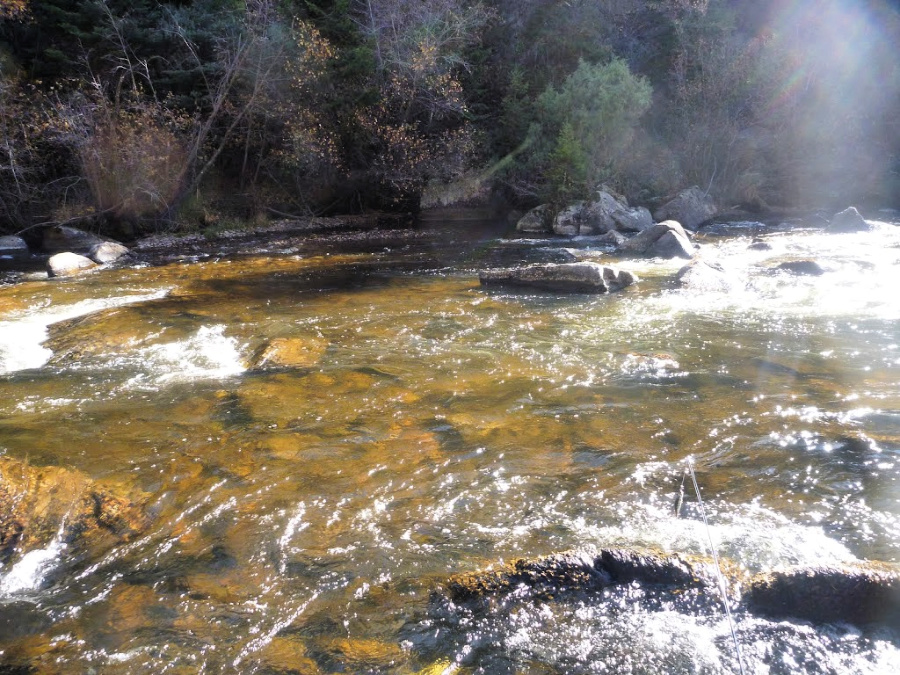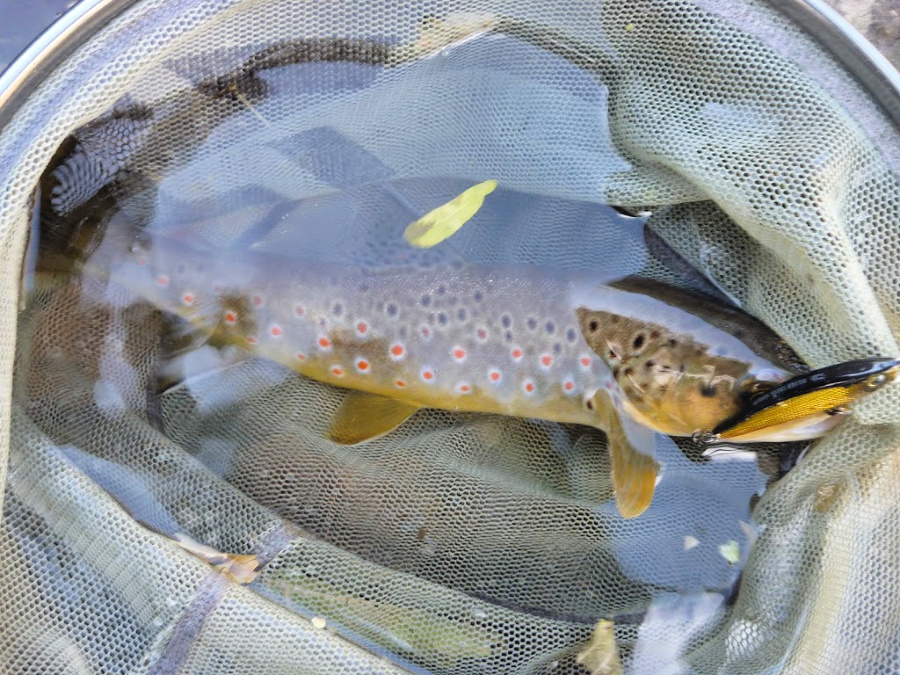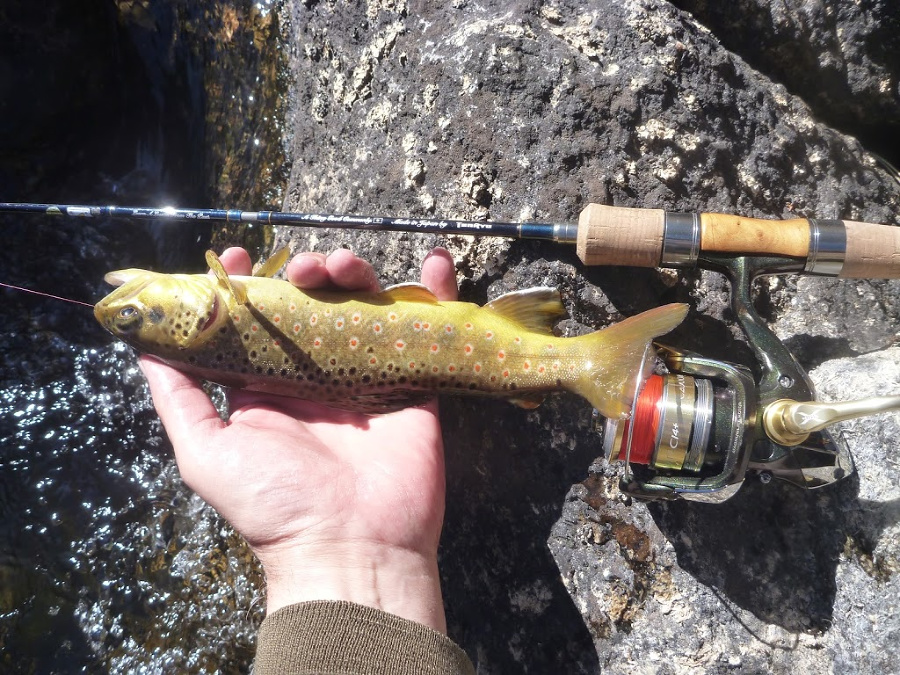The Flip Cast
I'd heard of the Flip Cast, but I couldn't do it. I just couldn't get the timing right.
This essay is taken from the 10-19-19 Trip Report, which chronicled a trip to Colorado during which Adam K taught me how he does a flip cast.
 The "classroom"
The "classroom"When we got down to the stream, Adam showed me his flip cast. Based on our previous conversations, my understanding of how he did it had been close, but not exact, and the difference was crucial.
With a flip cast, the rod is held directly in front of you, essentially pointing directly at your target. Start with a sharp (but short!) upward motion of the rod tip and then a more forceful sharp downward motion with your wrist. When your wrist motion stops abruptly, the momentum of the lure bends the tip further down and back, loading the rod. A very slight forward push with your hand loads the rod a bit further (because the inertia of the lure holds it back very briefly). You release just as the rod tip starts to recover. If you have timed your release perfectly, the lure will shoot towards your target with a very flat trajectory.
The part I hadn't understood was the slight forward push. I had been trying a slight upward motion of the wrist, which generally caused the lure to go much too high. Also, my release had generally been a fraction of a second too late.
[Reading this report months later,
I just realized that the slight forward push that Adam uses has the
same effect as the forward motion that Erne St. Claire described in his
Fer de Lance cast. Adam's cast is not the Fer de Lance cast, but as with the Fer de Lance cast, that
forward motion of his hand does use the lure's inertia to load the rod a bit more.]
The big advantages of a flip cast are: 1) there is
very little movement of the rod or your arm, so you are much less
likely to scare the fish you are trying to catch; 2) done well, the low trajectory
can deliver the lure under overhanging tree branches; 3) because your
rod starts out pointing directly at your target, your cast should always
go directly towards your target. Distance and elevation take practice,
but side to side accuracy (windage) should be right on almost from the very
beginning.
A good flip cast takes a lot of practice (timing the release is absolutely critical). I didn't get the timing right for every cast, but I got it right often enough to understand what I needed to do and what I needed to practice.
I'd started the lesson with Adam's Anglo & Co rod, which he had said does the flip cast very well. The best part of the lesson (at least for me) was after making the cast correctly a few times with his Anglo & Co rod, I was able to pick up my Tenryu Rayz Integral RZI50UL-4 and do the exact same cast.
You do need to get the timing of the release just right, but you also need a rod that is soft enough to load with just the quick downward wrist flick and slight forward push. The RZI50UL-4 worked just fine. Not to mention (OK, I'll mention it), the Tenryu Rayz Integral RZI50UL-4 is about half the cost of an Anglo & Co rod and there's no four-month wait!
 A 4.5 gram sinking minnow lure.
A 4.5 gram sinking minnow lure.Although the Tenryu RZI50UL-4 is rated for lures as light as 1 gram
(roughly 1/32 oz), you will need a heavier lure to make the flip cast
that Adam taught me. The key to the cast is loading the rod with the
sharp downward motion, and a light lure doesn't have enough mass to load the rod. A lure like the 4.5 gram Daiwa Silver Creek Minnow 50S is about right. The 5.5 gram Forest iFish AT makes the cast even easier.
A lure of about 4.5g also allows you to make longer casts, so you can target the bank eddies on the far side. If you can get the lure deep into a bank eddy, it probably won't land directly on top of a fish, scaring it, but will allow you to fish the seam between the eddy and the main current, as well as the full width of the stream back to where you are standing. In a stream like the one we fished, with lots of large rocks both above and below the surface (top photo), you could pick up a fish about anywhere along your retrieve.
 One of many.
One of many.We both caught a lot of fish that day. For me, though, the lesson was far more important than the fish.
Please understand that the flip casts Adam showed me are not the
same as the "wave" casts that Erne St. Claire and Joe Robinson wrote
about. To do the wave casts, one would need a rod that is much slower
and much softer than the Tenryu Rayz Integral RZI50UL-4. The Daiwa Iprimi 60XUL is the best production rod I know of for the wave casts.
If you want to do flip casts with lures that are lighter than the 4.5g Daiwa 50S Silver Creek Minnows, a softer rod like the Daiwa Iprimi 56XXUL-S or the Daiwa Presso ST 56UL-S would be a better choice. Both rods are rated for lures up to 3g, and will do a flip cast very nicely with a 3g Daiwa Silver Creek Spinner. If you want to do wave casts, though, the even softer, slower Iprimi 60XUL is the rod to get.
Home > Finesse Spin Fishing > The Flip Cast
Header photo: Tenryu Rayz RZ4102B-UL, Shimano Calcutta Conquest BFSHG ('17)
Warning:
The hooks are sharp.
The coffee's hot.
The fish are slippery when wet.